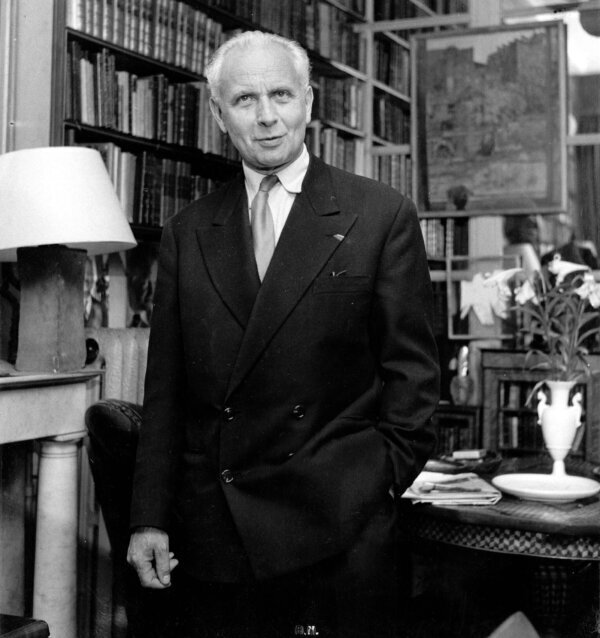Creation by Inhibition, Withdrawal, and Forgetting

Iain McGilchrist, in The Matter With Things, notes that one conception of God and the divine is that He created by withdrawing, by making a space. This is related to Lao Tzu’s Tao De Ching that comments that the essence of a cup is the hole it creates and encloses, just as a house is primarily about the space created within it. The womb in which life grows is an enclosure. Cups, houses, and wombs are characterized by absence.
Likewise, to have a thought, it is necessary to forget. To have all thoughts simultaneously is to be unable to think. One thought achieves salience, any others are inhibited. To remember something means to forget nearly everything and just retrieve a particular memory if and when it is desired. Remembering has to be optional. Our brains are, according to one conception, primarily valves and filtering and limiting devices. From a sea of the One Consciousness we pull that which we desire: channeling, limiting, excluding according to whim, character, interests, circumstance, desires and the nature of our imagination. Our thoughts become ours by getting rid of the rest. On this view, the physical brain provides resistance, creating an eddy in the flow like a rock in water, not entirely apart from the water, but nonetheless a distinct pattern discernible from the rest.
If we could not forget, we would remember everything simultaneously. We would have a kind of useless block consciousness. It would be comparable to having a permanently full stomach that did not permit eating. The stomach too is an emptiness that exists nearly as much by what it is not as what it is. Without the ability to forget, we could not think and we could not function. PTSD (post-traumatic stress disorder) involves intrusive memories that are disruptive and is a disease of remembering. To forget nothing and have it all present all the time, one would effectively remember nothing. One would not be able to isolate one memory from the rest in order to actively remember it. We tend to remember only the important things and forget the rest. This is useful and efficient. It does make memorizing things like Latin vocabulary hard, however. Clearly, some part of us regards it as unnecessary and unrelated to our survival.
Sometimes, human perception and memory is denigrated as defective and deficient if we have not noticed and cannot remember the color of houses on a street, or some such usually irrelevant thing. Attention is limited and takes energy. It makes sense to focus only on important details and to ignore and forget the rest. Alfred North Whitehead writes: “Civilization advances by extending the number of important operations which we can perform without thinking about them. Operations of thought are like cavalry charges in a battle — they are strictly limited in number, they require fresh horses, and must only be made at decisive moments.”[1] Most people find that three to four hours a day of “operations of thought” is the maximum they can manage productively. Procrastination generated adrenaline with a looming deadline can artificially extend this period, but it wreaks havoc on emotional stability and disrupts normal mental and bodily functioning.
The Many Worlds interpretation of Quantum Mechanics is a stuffed gullet theory too. Quantum physics contains the idea of a wave function which starts off in a superposition (many places at once). When the wave function is measured and the object is pinned down in some respect (like position or momentum) then the object is said to be in an eigenstate[2] of the measured property. An eigenstate exists when the eigenvalue is known. Under the “normal” interpretation, when the wave function is measured (i.e., observed) it “collapses” and the quantum state goes from superpositionality to a settled state of affairs, a single eigenstate, more in line with classical physics. Schrödinger’s cat thought experiment captures the phenomenon. Radioactive decay is an unpredictable quantum phenomenon. If a cat is put in a box in which poison gas is either released or not released depending on how a radioactive substance decays, then, according to quantum theory, the cat is neither dead nor alive, or both dead and alive, until the box is opened and the cat observed. The cat partakes in superpositionality. Schrödinger proposed the thought experiment, making a larger classical system depend on and follow the laws governing subatomic particles, as a reductio ad absurdum argument – trying to show that quantum physics implied ideas that a reasonable person should reject. Instead, the other quantum physicists just accepted the consequences – which is always a possibility with reductio ad absurdum arguments. “But that means you’ll have to shave your head, wear a loincloth, feed on locusts, and live in a cave in Timbuktu for the rest of your life.” “OK,” the person replies.
According to the Many Worlds interpretation, there is no wave function collapse when a measurement/observation is made, or rather, it collapses one way in one world and another in another world. Reality splits into two, so both possibilities are realized. (Physicists do not seem to be bothered by the fact that no mechanism is described for how this splitting is achieved.) Schrödinger’s cat is alive in one world and dead in another. Those “worlds” then continue on and split into many worlds again the next time a measurement/observation is made. This theory removes randomness from quantum mechanics. Bonald writes: “The “many worlds” theory has trouble explaining how the probability of any two-state observation could ever be anything but 50/50, regardless of the wavefunction. After all, there will be two of my consciousnesses, and there seems to be nothing that would favor any particular me being one or the other.”[3] Thus, according to this, a radioactive substance does not randomly decay. At least when it is measured to see what happened, the substance will have in fact decayed in all ways at once in multiple realities. The decay will only appear random in any one particular world. Since a particular observer exists only in one world at a time, randomness will still seem to exist. However, the observer exists in all the different worlds simultaneously, so there will be an effectively infinite number of the “same” observer. According to this theory, everyone has a near infinite number of twins all living in forever branching and dividing realities. Except, these twins have diverged from you and will go on to have different futures so they are not really “you” anymore. The movie called “Moon,” directed by Duncan Jones, David Bowie’s son, has one man stationed on the moon in a mining operation. He thinks he is receiving recorded video messages from his wife and child, but he is not. In fact, he is a clone of the original worker. Thanks to the cloning process, each clone does not last that long. His teeth and hair start to fall out after only a few months. As his decrepitude proceeds, each clone is told to climb into a capsule to be sent back to Earth to retire. In actuality, he is simply zapped into his constituent particles, disintegrated, and sent into oblivion. One of the clones descends into the basement to find an enormous number of fully formed clones in draws ready for activation, all versions of himself. The Many Worlds interpretation implies a similar horror show of pointlessness and replaceability.
Presumably, if a measurement is not made in this world, it will be made in another world, so the division into many worlds will continue on regardless of how one person in one world acts or does not act. If one looks at the entirety of what is being postulated, then nothing ever happens, McGilchrist points out. Effectively, no choice is made. It is always both, and thus, neither. If everything happens, nothing happens. We make a choice by excluding other options. Many Worlds stops this from happening. The Talking Heads have a song called, “Heaven,” with the refrain, “Heaven is a place where nothing ever happens.” Many Worlds is thus heaven, so-described.
McGilchrist notes that speech, less contentiously than consciousness, also involves a diminution and selection from a larger medium. Our larynx and vocal cords take from the Earth’s atmosphere a small portion of air. By limiting and constricting the air and passing it through the larynx we are given a voice. Speech is made possible by excluding nearly all air and then shaping it by a device that is unique to us, resonating too around our heads and sinuses. Air is not infinite as perhaps consciousness is, but relative to the individual, the larynx and brain stand in a similar relation to the larger medium it uses. This too could be seen as creation by limitation and restriction.
The brain as filtering device, or reducing valve, of a larger consciousness takes as fundamental an implication of physical determinism that undermines determinism. In order for determinism to work, and for the world not to descend into chaos, mind would have to undergird physical causes. To take out an umbrella on a rainy day and for that umbrella to function to keep the rain off, intentionally, on purpose, then physical determinism would be false, for determinism removes intentionality and purpose from the universe. In determinism, there are no “actions” by “agents,” just sequences of events pushed from behind by physical causation, not pulled from the future as goals. Determinism eliminates consciousness as having any kind of top-down effect. If humans have no agency, but function as mindless automatons inexorably following physical forces, then that opened umbrella represents some kind of miracle. At the very least, it would be an almighty coincidence since it would not be a matter of minds “deciding” anything. To get the umbrella opening to line up with events correctly, Mind would have to undergird physical reality. And that Mind would have to be nearly omniscient. It would have to know, after the hot plasma of the Big Bang had occurred, that this would lead to stars, then solar systems, then to life emerging on at least one planet, then for evolution to exist, for that evolution to lead to the phenomenon of human beings, for human beings to invent umbrellas, and for human beings having an aversion to getting wet unless swimming or showering. Logically, for determinism to work, Mind would have to undergird physical reality, so ending physical determinism.
Minds are capable of following reasons and logic. To get the physical events in the brain to produce arguments and reasons those brain events would have to themselves be shaped by mind. Mind → Brain → Mind. The mind that has gone through the reducing valve of the brain can and does affect the brain. Placebos involve thoughts and beliefs altering the brain. When people are given placebo painkillers, and those placebos work, then the brain does in fact release real dopamine in exactly the same manner as “real” painkillers. So, this would be Brain ← Mind: the personalized mind shaping the brain. Just as someone’s body has various capacities, tendencies, and limitations, so does the brain. The Big Five Personality Traits are inherited at 0.4 to 0.6. Intelligence, as assessed by IQ measurements, is inherited at 0.8. So, the reducing valve of the brain is built with inherent characteristics of its own. An autistic brain will tend to produce one kind of mind rather than another. A properly lateralized brain will give less lopsided results. It probably does not make sense to attribute agency to the brain, as a hunk of meat. The brain would somewhat mechanically and automatically filter Mind, the One Consciousness. The resulting individual consciousness in turn alters the brain through asking it to do repetitive tasks. What the brain is not asked to do is pruned away and the frequently called for abilities are strengthened and made more fluid. Following this train of thought, the brain is a tool with its own characteristics which can be altered, to an extent, by how the tool is used. Agency, however, resides in the mind, not the brain.
Rupert Sheldrake in his book Science Set Free (The Science Delusion in the UK) writes about attempts by scientists to understand memory. Both Sheldrake and McGilchrist note that memory survives the transmutation from caterpillar to moth despite most of the caterpillar’s nervous system being dissolved in the chrysalis. If the caterpillar is trained to be afraid of something, the moth will retain that fear. One thing that has not been found are “memory traces.” Memory traces are postulated connections between parts of the brain that permit the retrieving of memories. An experiment Sheldrake mentions involved chicks pecking at food. When they pecked colored lights, it made the chicks sick and so they avoided them. The chicks’ brains changed in reaction to this information. The part of the brain that had changed was then removed, but the chicks went on remembering anyway. Karl Lashley had monkeys solve a puzzle, a box with a complicated mechanism, in order to get access to food. Once this memory was formed, there was nothing the experimenters could do to make them forget it, including making deep grid-like incisions in the brain designed to cut any connections between the front and back of the brain, and the left and right sides of the brain. They removed the motor cortex, resulting in paralysis in the monkeys for two to three months. When the monkeys recovered, they opened with box with no preliminary exploratory movements. The hippocampus seems to be involved in mice learning mazes, but removing the hippocampus did not affect their memories of the maze. There seem to be parts of the brain such as the motor cortex or hippocampus involved in forming a memory, but once the memory is there, that part is not required for the existence or retrieval of the memory. The memory is described as being “broadly distributed.” Nowhere specific and everywhere at once. On the brain as filter model, the memory would not be “in” the brain at all.
When a child learns to recognize a dog, or a cat, it takes just a few samples to get the concept. When computer scientists try to do the same thing with a neural net, the neural net is exposed to millions of samples. It is trained on a giant database. The more, the better. In trying to write, a GPT-3 chatbot also relies on millions of sentences and uses statistical techniques to try to anticipate the next word. A dumb, brute force method. Children, on the other hand, learn languages easily and spontaneously, somehow grasping the difference between verbs, nouns, adjectives, subjects and objects and so on. Chimpanzees raised in the same environment never learn language. They have no such natural proclivity and linguistic ability. How the child does what it does is unknown. Noam Chomsky called this universal human ability and near-immediate understanding of speech and language, and awareness of its significance, “deep grammar.” One possibility is that the child is filtering the One Consciousness. Its brain prunes neural connections, getting rid of all that is irrelevant and unneeded, permitting conscious thought, speech, selective memory, and all the rest.
There is an interesting comparison to be made, perhaps, between the filtering function of the brain, and neural nets. Neural nets have no access to the One Consciousness, so they rely on an enormous database in a game of autocomplete. Out of thousands of choices, which word is most probably going to come up next? A human can recognize the same face in different lighting conditions, with a beard, without one, earrings, hats, make-up, even prosthetic make-up in some instances. A computer must actually be fed many of these variations to do what a human can do spontaneously.
The left and right hemispheres function partly by inhibiting and suppressing the activity of each other. Without this inhibition, the brain would be trying to do two incompatible things at once. Talking while programming a computer activates competing parts of the brain and hinders performance. The LH verbal part needs to be silenced. And, activities that have become automatic are driven by the LH and the RH needs to be suppressed. Skillful behavior can be undermined if one starts to actively pay attention to what one is doing. Self-consciousness in public speaking stops the flow of words and decreases performance. There is a time to think and a time not to think.
McGilchrist points out that we are so much more than that of which we are conscious. There are between 200 and 600 million neurons in our gut sending information upwards to the brain. The RH does what it does mostly wordlessly and egolessly. The moment of insight or inspiration comes from we know not where. Our bodies and souls perhaps shape and channel the One Consciousness with only part of that breaking through to conscious awareness. We find that we love people, or books, or music, not as the result of a conscious decision. The mystery that is us taps into the mystery that is All and contributes to that All.




